|
|
|
crossing snow on flip flops
Wednesday, June 24 2009
setting: east-central San Juan Island, Washington State
The night before last we'd experienced some noise discomfort from the people staying in the room directly above us. Whoever they were, they seemed to like to pace back and forth while wearing heavy shoes. I can understand pacing back and forth (a little) and I can understand wearing clunky shoes, but the combination is sadistic when you're staying in a room on the second floor of a hotel, particularly one where the floors aren't three feet thick and made of sheets of lead interleaving sheets of styrofoam. Evidently we had a different upstairs neighbor last night, because both the pacing and the clunky shoes were gone. Our new neighbor behaved more normally, getting up perhaps every three hours or so and walking quietly to the bathroom in slippers or socks.
Today we'd be returning to the North American mainland, and this meant abandoning my copy of Zen and the Art of Motorcycle Maintenance behind. So when we got to Friday Harbor, we didn't just shop for snackfood in its supermarket and get coffee from one of its dozens of coffee retailers, we also waited for its used bookstore (just above the ferry lanes) to open so we could get me a replacement copy of a book into which I'd already waded some eighty pages. Sure enough, the book was there, in paperback. $3.50 later, and it was mine.
If one is taking the ferry to Anacortes from Friday Harbor, it is assumed that a round-trip ticket has been purchase and nobody checks to see that your papers are in order. They just point you to a lane (which may or not be among the lanes that the sign says, thus ensuring employment for aging dog-loving bleach-blondes) and you wait.
Rain fell on the ferry ride back to Anacortes, and as I scanned the water for orcas, I noted that the weak-flying guillemots could fly a bit faster than the ferry could sail.
It was still raining as we drove past the farm stands of northwest Washington, some of them displaying placards with Christianist propaganda. At some point I desperately needed to piss, so I got out at paved entrance to a field of agricultural crops and saw three or four black slugs, each about five inches long.
Approaching Seattle, the sun started breaking through and there was some hope maybe we'd get a little preview of our next destination, something I'd been hoping to glimpse since landing through opaque clouds into Seattle on Friday: Mount Rainier.
We continued south in the HOV lane down I-405 past Seattle. We'd thought there would be an exit in the HOV lane for Route 167, the next in the series of roads we needed to take, but there wasn't and I got temporary jammed in traffic as I tried to merge into congestion in the rightward lanes. A big SUV behind me narrowly averted rearending me, its driver slamming on the brakes in a desperate effort to slow all that unnecessary mass around him, mass that had taken a fortune in gasoline to accelerate to the speeds it was going. I saw him in the rearview mirror just before I merged, positioned at some absurd angle in traffic, just inches from my bumper.
Routes 167 or 161 are a kind of Anywhere, USA, with plenty of Targets and Applebees. But there's one major thing that sets this place apart from all the other Anywheres, USA. Off to the east is a colossal snowly mountain that reaches into the skies. I've seen a lot of things in my life, but I have never seen anything on the surface of the Earth so fucking big. When I briefly spied a similar snow-capped volcano on the equator in the Andes, it also blew me away, but it was part of the Andes and hard to separate from that interfacing mass and thus the world beneath it. This thing, Mount Rainier, had no such interfacing mass. There it was, a huge snowcapped thing in summer, on the surface of my home planet. For the rest of the drive, I didn't care what else there was to see, all I wanted to see was Mount Rainier.
The mountain always stayed to our left as we approached it, which was a little confusing since it seemed it would have to be on our right at least some of the time or else we'd drive past it. What I didn't know was that we were following a spiral-arm trajectory towards it, heading first southward to its west and then eastward to its south. An old wrinkle-faced cowboy set us straight in Eatonville when we feared Google Maps might have steered us wrong.
Eventually we were so close to Rainier that it had vanished behind the local terrain, although some of this terrain still had snow on its peaks, the weirdness of which kept me visually entertained in the absence of the mountain itself.
The place we'd be staying tonight was the Wellspring Spa just to the southwest of Mount Rainier. It was a beautiful collection of rustic cottages amid lush rainforest. Most of the buildings were made of heavy-timbered carpentry and detailed with quirky scraps from felled trees. It's easy, it turns out, to make things like coat hooks, toilet paper holders, ballustrades, and interior trim if you just find the right branch crooks and them cut them correctly.
The Wellspring Spa seemed to be run and occupied by ghosts. There was a fairly large parking lot, but ours was the only car in it. During our entire stay, we never saw any other human beings, though we did ocassionally hear a car pull in and a truck that had been in a garage eventually disappeared.
Al Gore stayed at the Wellspring when he climbed Mount Rainier, but he stayed in one of the high-end cabins, perhaps the one with a built-in greenhouse or the one with its own enormous global-warming-encouraging hot tub. We were staying in Wellspring's cheapest cabin, a treehouse ten feet above the ground on a triangular platform between two large trees and an old telephone pole. It didn't have its own bathroom, but it did have a coffee maker, a hammock, and a refrigerator. It also came with a "top secret box" containing vintage comic books and a old television attached to a DVD player (though we didn't have any DVDs). The bathroom was in another building, and it seemed to be for our exclusive use. Unfortunately, it lacked a bathtub.
After we were sufficiently stoked with the excitement of our treehouse, we drove into Mount Rainier National Park, got some literature, and then made haste towards the most exciting visitor center in the park, Paradise. Paradise is at an elevation of 5400 feet, but the cute rangerette at the gate had warned us that if we wanted to go hiking there, we'd better have boots "because of the snow." That didn't scare me. I could think of nothing more exciting than being thwarted by snow on a hike attempted in summer.
Heading up the mountain, occasionally we'd break out of the forest along a deep valley. These were actually glacial valleys that hadn't been long abandoned. They were strewn with rubble through which flowed the clearest water you can imagine, water that a couple miles upstream was a melting glacier. We took lots of pictures, particularly when we could see the mountain itself, its distant peak lots in clouds.
Amazingly, at Paradise the fields of snow came right to the edge of the parking lot. We weren't the only people amazed by it; a couple dozen people, many of them children, were on the hill above the visitor center sliding around in the snow as if they were on vacation from a tropical land. I'd been picturing a few swaths of snow lingering in swales, but according to the whiteboard in the Paradise visitor center, on average the snow around Paradise was still six feet deep. But even that was only a tenth of the snow that had fallen throughout the past winter.
But we'd come to Paradise, so damn it, we were going to do some hiking. Gretchen was wearing socks and Tivas, but I was only wearing shorts and flip flops, a pair I'd bought back in 2002 and had had to repair once after they catastrophically failed while I was exploring a gorge several hundred feet from home.
We set off across the snow, following little flags that had been placed every so often. The path was well packed from thousands of footfalls, but it was also a little slippery from surface meltwater. For snow that had lain around through an entire spring, it was amazingly clean.
It didn't take long before we'd left the roughhousing kids near the visitor center and were alone in a winter wonderland. By taking careful steps, I was able to mostly keep the snow away from my toes, but over time they began to hurt from the constant exposure. This unpleasantness would occasionally be broken by the parting of the clouds. The sun would break through and bathe us in the most powerful winter sun I've ever encountered. This was because it was actually the summer sun only days after the solstice, augmented by the vast acres of brilliant white snowfields around us.
It's hard to imagine life figuring out a way to exist in a place where snow lays around until well past the beginning of summer. But all around us were trees (they were either fir or spruce trees), many of them standing in deep holes in the snow. Some had been squished completely flat by it (we actually saw a small tree spring up while we were there, it's annual instant of freedom).
After we'd hiked a ways up the hill, past a couple others, one of whom was laughing hysterically, perhaps at my footwear, we took a vacation from the snow by sitting on a rare patch of bare ground, the crest of a low rampart on the face of the mountain. It was a little island of what, for this area, was early spring. Lilies were blooming and the grass was green. Ants marched along branches doing the things their fascist genomes commanded.
Once the numbness had left my toes, we decided to head back down the mountain. But going down the mountain was much more difficult than climbing it had been. Because of the necessary braking action, it was hard to take a step without sliding, and even when we didn't slide, the snow tended to fly about unpredictably, much of it landing on my toes. They went numb again after only a couple hundred feet of walking. Eventually we took another break on another patch of clear ground. I was worried I might injure myself if I continued hiking without feeling in my extremities, though I wasn't worried about normal winter survival issues. There was zero chance of either hypothermia or frostbite; my circulatory system could easily keep pace with keeping my toes from freezing, particularly since the snow itself had already risen to the melting point.
Before we set off for a second time, I urinated on my toes, which immediately snapped them out of numbness. From their perspective, at least as reported through my nervous system, my urine felt like a delightfully scalding hot shower.
Down near the visitor center, a chubby young lad asked if I'd seen a "phone" on the snow (the youth of today don't use the word "cellphone"). I hadn't, though I didn't think to ask him to attempt to call it. But to have made such a suggestion would have been useless. There is no reception on Mount Rainier unless you're way up on its glaciers.
At the visitor center, we went to the bathroom and washed our feet in warm water. I started with cold water and raised the temperature slowly for fear of scalding toes that still had no feeling. As feeling returned, my toes began to itch. But in only a couple minutes they were completely restored to normal. I didn't use the hot dryer, something Gretchen was doing in the women's room.
Driving down the mountain, I saw a marmot scurry across the road. It was muscular like a wolverine and still had a patch of creamy white fur on its rump. Like something out of Star Wars postquel, it scurried across a snowbank and disappeared into a hole that I imagined was full of advanced electronics.
We stopped on the way down to look at a waterfall and then, near the National Park Inn in Longmire, we hiked on a trail through some climax forest in the lowlands. But it was all pretty anticlimactic, literally.
We had dinner in the restaurant of the National Park Inn. It looked like a charming old building on the outside, but inside it was a dreary place that hadn't been redecorated since the 1970s. I'm sure the dining room had beautiful flooring down there somewhere, but it was hidden beneath hideous forest green wall-to-wall carpeting. There a few other people there, but they looked like they might be a tour group from a old folks' home. The only other table having youngish people at it looked like they came from Borat's version of Kazakhstan, with shirts and pants making an æsthetic statement completely compatible with the carpet. It didn't help that our waitress was unnecessarily unpleasant, failing (for example) to reiterate the list of salad dressings as I tried to select one a bit more vegan than my usual favorite (blue cheese). The food itself was completely flavorless, though it wasn't completely unsalvageable given that we had salt and pepper at our disposal.
Our evening ended pleasantly up in the cozy nest of our treehouse. I borrowed a screw hook from one of the buildings and used it to uncork the bottle of table wine we'd bought yesterday. Wine glasses had been provided with our room, so we sipped our wine and read our books.

A ferry at a small landing, probably Lopez Island.

Cormorants nesting in the ferry docking hardware at Anacortes.

On State Route 7 on the way to Mount Rainier.
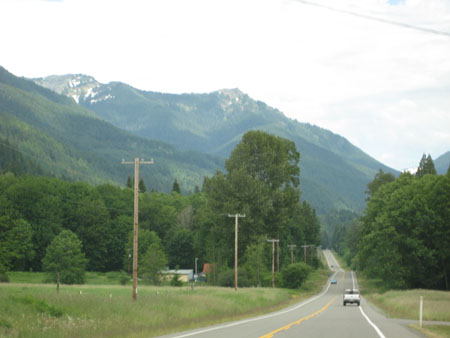
Snow on the peaks of foothills as we approached Mount Rainier.
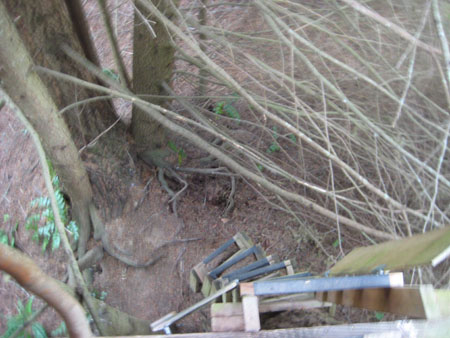
The steps up to our treehouse at Wellspring Spa. There were lockable plywood flaps to cover some of the rungs to ensure privacy.
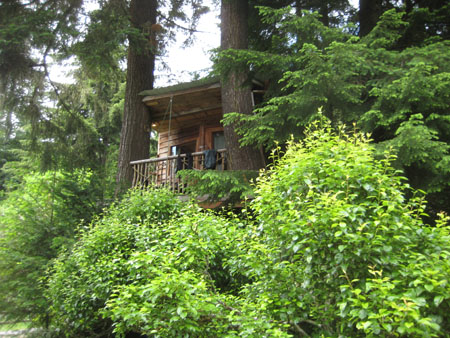
Our treehouse from below.

Another of our treehouse from below.
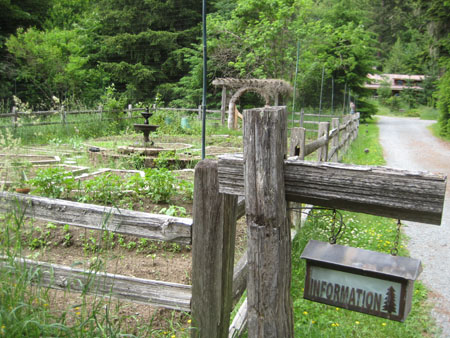
The garden at Wellspring Spa.

Mount Rainier from just below it.

One of the glacial valleys on the way to Rainier, perhaps the Nisqually.
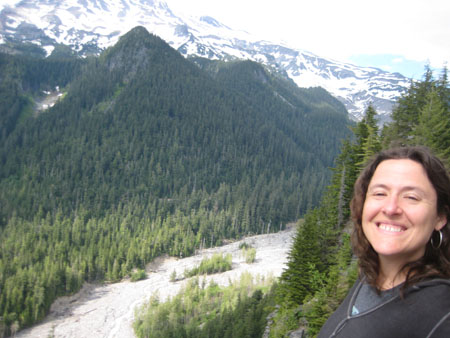
Gretchen.

And then me.
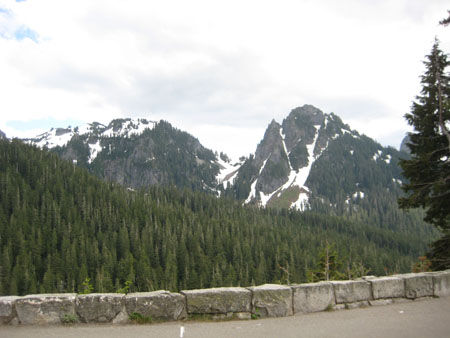
Anciliar Ridge near Mount Rainier on the road to Paradise.
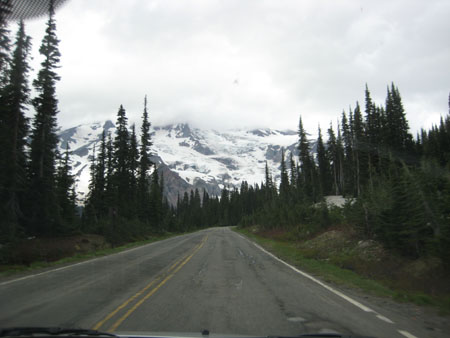
Driving up to Mount Rainier.

The Tatoosh Range, which lies to the south of Mount Rainier proper.
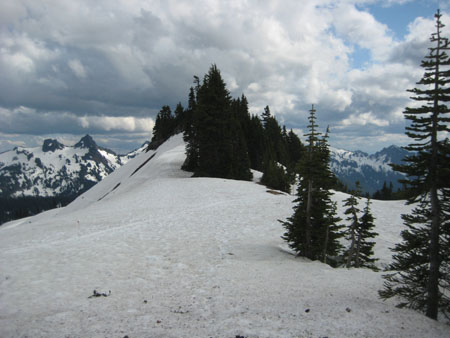
A view from where we rested above Paradise before turning around to go back down.
[REDACTED]
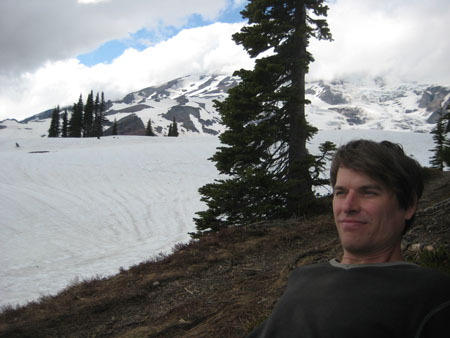
Me.
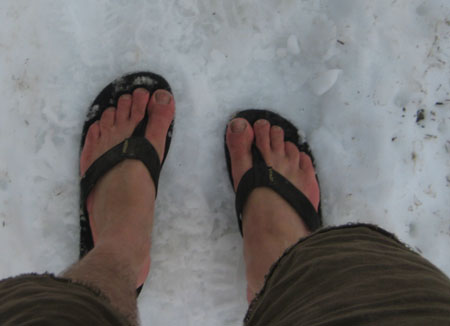
The way I walked across snow above Paradise Jackson Visitor Center.

My feet after walking over a half mile across snow in flip flops. I pissed on them to restore feeling.
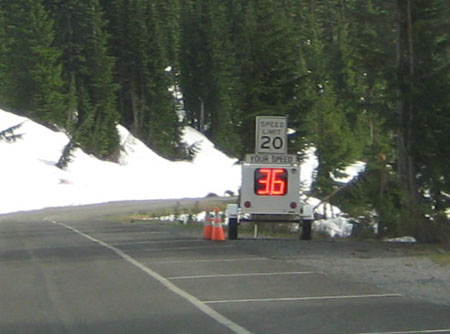
I tried to get Gretchen to drive faster for this picture.
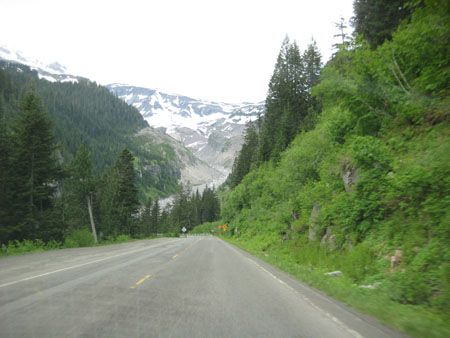
Driving down the mountain.
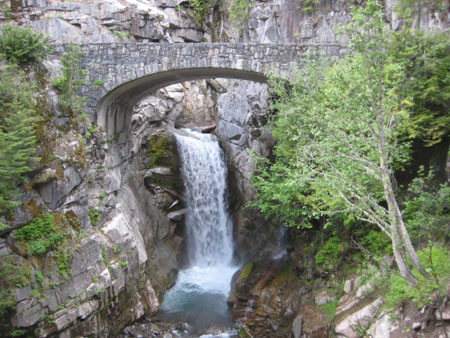
Christine Falls.
For linking purposes this article's URL is:
http://asecular.com/blog.php?090624 feedback
previous | next |





















